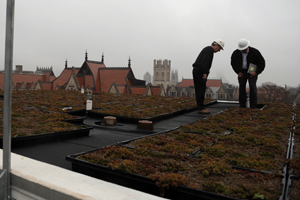Will to sustain
Energy-intensive Ilsa Flanagan works to make sure the University is not.
By Jason Kelly
Photography by Dan Dry

Searle’s green roof is one of several features that reduce the building’s energy use.
When she became the University’s first sustainability director in November 2008, Ilsa Flanagan discovered a quick path to the professional compost heap. “I’d tell people we should have an energy policy, and they’d say, ‘If you want to lose your job in the next two months, tell people that.’” Flanagan said. “They don’t like policies at the University of Chicago.”
Decentralized Chicago might not take to policies, but the University’s interdisciplinary crosscurrents generate energy that aids Flanagan’s efforts. Her previous employer, LaSalle Bank in Chicago, had a top-down structure both in its organizational chart and its 43-story headquarters. The University environment is different, and so its approach to sustainability has to be as well.
Any successful plan, Flanagan said, must be specific to its place. During a November 12 talk at the Gleacher Center, she described how she tries to marshal the University’s strengths toward finding “uncommon solutions.” Because needs differ between divisions and buildings, common sustainability solutions often do not apply across the board to construction projects and day-to-day facility operations.
Safety issues affect environmental efforts at energy-intensive laboratories, for example, requiring creative ways to achieve sustainability standards. Although office buildings can recirculate air, sites such as the recently renovated Searle Chemistry Laboratory require that air pass through only once for the occupants’ health. To reduce waste, the Searle renovation incorporated motion-detecting fume-hood technology. If nobody is in the area for an extended period, a hood sash closes to limit air flow.
Several other features helped Searle’s renovation meet the U.S. Green Building Council’s Leadership in Energy and Environmental Design (LEED) certification standards. At least 90 percent of the existing walls, roof, and floors were reused in the project, and 92 percent of construction waste was recycled. Searle also has a green roof, which mitigates storm runoff and reduces energy use by cooling the building in the summer and heating it in the winter.
Not all environmental efforts are as dramatic as a building renovation, or as easy to measure. Many divisions handle their own purchasing, which makes it difficult for Flanagan to implement blanket rules about green materials. Independent departmental budgets also make campus-wide data difficult to collect.
Flanagan, who must corral factions facing varying environmental challenges, summed up her role with a photo of Mr. Rogers and a simple maxim: “Be nice.” Sustainability, she said, often carries a negative connotation, a perception that requires a gentle hand to change. “People think in terms of deprivation,” Flanagan said. “A sustainable life should be a vibrant, rich, robust life, and a sustainable campus should be a vibrant, thriving place.”
It’s already a vibrant place. Within the 211-acre Hyde Park campus, 30,000 people live and work in 257 buildings. From an environmental standpoint, Flanagan said, “it’s all about the buildings.”
The impact of those facilities is so essential to campus sustainability that former Board of Trustees chair James S. Crown donated $2.5 million last year to study greenhouse-gas emissions and energy use in buildings, and to implement efficiency upgrades.
Such sweeping initiatives make up only part of Flanagan’s portfolio. The subjects that cross her desk range from the big picture to the pixel. To encourage recycling, she expanded the use of single-sort bins, which studies have shown to be a subtle change that produces a dramatic participation increase. And it’s worked: since her arrival in late 2008, the University has diverted 30 percent of its landfill waste into recycling.
Under Flanagan’s direction the word “recycles” itself has taken on an added meaning; it’s the name of the University’s new free bike-sharing program. Blackstone Bicycle Works, a neighborhood nonprofit that trains kids to fix bikes, refurbished 20, sold them to the University, and performs the maintenance.
Another initiative, SAGE (Sustainable Actions for a Greener Environment), enlists volunteer student ambassadors to help educate the University community about sustainability practices like electronics recycling and using green cleaning supplies.
With the broad range of issues she faces—green construction, composting, energy-efficient light bulbs, paper towels versus hand dryers, double-sided printing—Flanagan welcomes the help in preaching the sustainability gospel. She hears plenty of preaching herself, predominantly from people pitching products, proof that the word “green” does not apply to environmental concerns alone. “I probably get two to three calls from vendors daily, saying, ‘I’ve got the best cubicle material, the best carpet, the best whatever.’”
Determining what’s best for the University remains an ongoing discussion, which Flanagan intends to continue until the idea of a sustainability director becomes an anachronism because a green approach has been integrated into the culture. “You want to work yourself out of a job,” she said—not that she would make it a policy.WRITE THE EDITOR
E-MAIL THIS ARTICLE
SHARE THIS ARTICLE
ALSO IN CHICAGO JOURNAL
RELATED READING
- "Advance Sustainability Planning Helps Make a Greener Campus"
(News Office, September 21, 2009)
